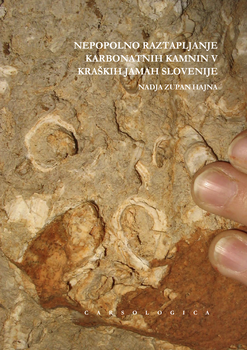Nepopolno raztapljanje karbonatnih kamnin v kraških jamah Slovenije
Raziskave, predstavljene v monografiji, so bile posvečene nepopolnemu raztapljanju apnencev in dolomitov v kraških jamah; to je pojavljanju debelih, mehkih con »topnega« ostanka karbonatnih kamnin. S terenskimi in laboratorijskimi analizami sem skušala spoznati, kaj se dogaja v karbonatnih kamninah med preperevanjem in zakaj se popolnoma ne raztopijo. Raztapljanje prodira v kamnino po različnih strukturah in teksturah. Rezultati analiz so pokazali, da se tako apnenec kot dolomit med preperevanjem čistita; izlužijo se Mg, Sr in U, struktura kamnine pa obenem postaja vedno bolj porozna. V primerih, ko je površina preperele kamnine v stiku s tekočo vodo, voda z njene površine trga izpostavljene delčke in jih odnaša. Če voda ne teče dovolj hitro čez izpostavljene delčke, ostanejo na steni rova. Razmerje med korozijo in mehansko erozijo karbonatne kamnine v steni jamskega rova je bolj pomembno za oblikovanje hrapavosti in različnih skalnih oblik na stenah kot pa za samo rast rova. Mikroorganizmi so prisotni, ne vemo pa še ali sodelujejo pri preperevanju. Iz raziskav sledi, da so cone bele porozne kamnine na jamskih stenah produkt preperevanja in ne izločanja sekundarnih mineralov.
Research represent in this monograph (Incomplete Solution Of Carbonate Rocks In Karst Caves Of Slovenia) was dedicated to incomplete solution of limestones and dolomites in karst caves; that is to occurrence of thick, soft weathered zones of “soluble" residue of carbonate rocks. With field and laboratory analyses I have tried to find out what is happening within the carbonate rocks during weathering and why they do not dissolve completely. Solution penetrates into the rock along various textures and structures. Results of analysis have shown that during weathering limestones and dolomites become purer; Mg, Sr and U are leached out, structure of the rock becomes more porous. In the cases when surface of weathered rock come in contact with flowing water, the water tears exposed particles and transports them away. If water does not flow over the exposed particles fast enough, they remain attached to the wall of the cave. The ratio between corrosion and the mechanical erosion of carbonate rocks on cave passages walls is more significant for the formation of roughness and rocky relief on the wall than for the growth of the passage. Microorganisms are present in the processes, but it is not yet known if they contribute to the weathering. From research follows that zones of white porous rock on cave walls are a product of weathering and are not precipitated secondary minerals.
Downloads

Series
License

This work is licensed under a Creative Commons Attribution-NonCommercial-NoDerivatives 4.0 International License.
